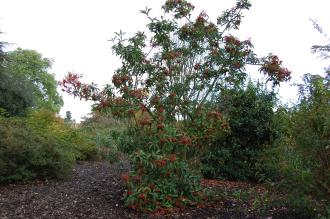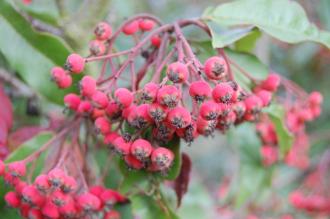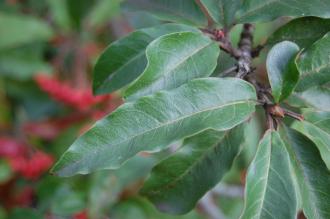
Photinia davidiana (21/10/2013, Kew Gardens, London)
Position: Full sun to partial shade
Flowering period: Spring
Soil: Moist, well drained
Eventual Height: 5m
Eventual Spread: 5m
Hardiness: 7a, 7b, 8a, 8b, 9a, 9b, 10a, 10b, 11
Family: Rosaceae
Photinia davidiana is an evergreen shrub with a bushy habit. Its leathery dark green leaves are elliptic to lanceolate with entire margins, up to 12cm long and 4.5cm broad. Some of its leaves turn red in autumn before they fall. Its white flowers are up to 1cm across, appear as panicles which are up to 10cm across. Its red fruit are pomes which appear in autumn.

Photinia davidiana Berries (21/10/2013, Kew Gardens, London)
Photinia davidiana, commonly known as Stranvaesia, is native to west, central and south China, extending over the border to Vietnam. In its native habitat it grows in thickets and damp gullies. Photinia davidiana is synonymous with Stranvaesia davidiana.
The etymological root of the binomial name Photinia is derived from the Greek photeinos meaning ‘shining’ in reference to its glossy leaves. Davidiana is named after Father Armand David (1826 – 1900), a french missionary and naturalist.
The landscape architect may find Photinia davidiana useful as an attractive hedging species. Once established this plant is drought tolerant.
Ecologically, Photinia davidiana flowers are attractive to pollinating insects. Its fruit are attractive to some birds late in the winter season ,after the more tasty berries of other plants have been eaten.

Photinia davidiana Leaf (21/10/2013, Kew Gardens, London)
Photinia davidiana prefers moist, fertile, humus rich, well-drained soils. It prefers a neutral to acid pH of soil.
Photinia davidiana requires little maintenance. Hedge cutting should be carried out in late winter to early spring.

